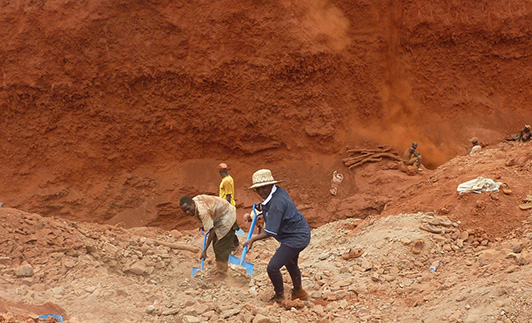|
Colored Gemstone
Kenya’s Gem Challenge
Kenya has a large gemstone industry, but it is mostly small-scale miners struggling to survive.
By Sheryl Jones
 | | Diggers at a community tsavorite mine. Photo courtesy Majala Mlagui. |
Over 50 years ago, Campbell Bridges created an entire gemstone industry in Kenya that didn’t exist until his discovery of tsavorite. Since then, Kenya has become known for high-quality chrome green, black and lemon-lime colored tourmalines, red garnets, rhodolite, aquamarine and spinel. The selection of material may have increased, but mining in Kenya has remained mostly artisanal or small-scale operations, much as it was when Bridges started.
Understanding the struggles miners faced, Bridges believed in the importance of creating organizations like the Kenya Chamber of Mines to help local miners band together to have a stronger voice and petition the government as one. He also knew that setting standards for the industry was necessary, which led him to create a guide to artisanal mining. But numerous challenges for artisanal miners have remained. They are still struggling with a lack of knowledge about gemstones that includes understanding a stone’s quality, gemstone valuation, the ability to access markets and get fair prices, as well as processing rough into faceted stones, an effective system to solve land disputes, equipment issues and safe mining practices.
Majala Mlagui, a Kenyan woman, also saw these challenges and how they affected miners when she visited her grandparents who live in Chawia in Taita Taveta, the coastal region of Kenya. Local miners would tell her about their problems marketing their stones and they would ask her to find out if their goods had value in England, where she was living at that time. She realized they did and that many of the miners needed education and the ability to market their goods in order to get the best prices. Mlagui began working with the miners and recognized there was a long-term policy issue that needed to be addressed. In 2012, she founded Thamani Gems, which means “value” in Swahili. “My organization’s priorities were policy, advocacy and community sensitization on mining issues and lobbying for policies and awareness that would better facilitate business for artisanal and small-scale miners, especially in the gemstone industry in Kenya,” Mlagui explains. Her mission now includes a mine-to-market concept selling rough and polished goods from miners to wholesalers, designers and manufacturers. Since Mlagui began Thamani Gems, changes in government appointments and policy have started the process of solving some of the issues the miners face. According to Mlagui, in 2013 the newly elected president of Kenya, Uhuru Kenyatta, created new ministry of mining to provide more transparency in mining. Mlagui explained, “The government has put a system in place to process the reviewing of mining regulatory framework, including addressing issues such as royalties, community consent on mineral concessions and formalization of artisanal mining. This process was part of a new mining act signed into law by President Kenyatta in May 2016.”
YOU MUST HAVE JAVASCRIPT ENABLED TO VIEW THE SLIDESHOW
Porini Gems, a Nairobi, Kenya–based mining and manufacturing gemstone company, owned by Diana Atieno, hosted the “First Annual Gem Affair Conference” in 2015 to create awareness within the gemstone industry. The two-part event was held in Nairobi and Voi. She believes one of the biggest challenges to cutting more gemstones in Kenya is increasing the value before export. Furthermore, Atieno is exploring opening a school in Nairobi that would give women more job opportunities, which in turn would be a way to create equitable wealth distribution. Mlagui believes miners need a better understanding of the market and trends so they can start thinking long-term instead of only what they need to do to survive now. “It is challenging to get them to think about investing in things that will help them in the future,” she says, “like how to deal with the overburden, the soil that is created in the mining process, or the need to wear masks and build proper openings to mine shafts.” She goes on to say miners often view dealing with these issues as hindering work and taking away from making money. “But if they had the training, they would know that dealing with these issues correctly helps create a better environment, longevity for the land, protection for miners and a stronger economy,” she concludes.Article from the Rapaport Magazine - July 2016. To subscribe click here.
|
|